

 |
 |
Abstract
This session will look at strategies employed to scaffold writing tasks in IPT using Virtual Environments to (a) Improve the QUALITY of the students response; (b) Support the LEARNING; (c) Encourage ENGAGEMENT; and (d) Validate AUTHORSHIP of the writing. The presenter will focus on two virtual environments: MOO (Multi-user Object Oriented virtual environment), and Moodle Learning management system, examining strategies used and demonstrating student response.
This document is available in a complete form in PDF format [820kb]
Assessment that is not done in exam conditions [the "dreaded" un-supervised assessment] should not be dreaded at all, rather embraced for the opportunities it provide students and teachers in active learning. Project work is a mandatory and significant aspect of the IPT Syllabus, so it is not like we have a choice, and I for one am grateful of that. Projects can be short term, hands on, written or demonstrative. They can involve research, investigation, engage the student in exploration of a topic or thread and fit contextually within the curriculum they are being done in [well, at least, that is the theory].
In the building industry, when trades people construct things, they erect scaffolding around the erection as it is built – to support its development, to allow access to all levels of the building and to catch stupid people who might fall off it. Building scaffolding around a project performs much the same purpose.
Project scaffolding can be as simple as a stepwise explanation of what needs to be done, template process or step-wise hoop-jumping exercise. I like to think of scaffolding conceptually on two levels – vertical and horizontal.
Vertical scaffolding is "total project scope" scaffolding – structural information on the whole task, the sequence, relevance, timeline - the meta-task. Interestingly, most teachers have usually done a reasonable job of this.
Horizontal scaffolding differs from vertical in that it provides blueprints of what to do at each stage in the sequence described by the vertical scaffolding. Traditionally we have shied away from this, assuming the rigor was in the student's ability to work out what each step requires. Teachers live in fear that horizontal scaffolding appears to "dumb-down" the task and I would argue that is entirely incorrect.
Scaffolding of projects and writing tasks provides students with starting points – the scaffolds themselves do not write the response, merely prompt for what is acceptable and appropriate, where and when. Properly constructed, they elicit structured and elegant responses, as opposed to carbon-copies.
Projects or assignments are used to engage students either collaboratively or singly in deeper learning, to explore a topic, to allow students to demonstrate their "elegance and flair" [words from the IPT syllabus that indicate students that typify standard A in the research and development criteria]. Although the syllabus mandates projects, there are many good reasons to explore them even if that were not so.
If projects are well constructed and suitably open ended, they cater for the complete range of abilities. If they are monitored [that is, if the teacher takes an _active_ role in the project] then the student feels supported, readily makes connections to class work and actually hands it in. The quality of the design and support the student experiences can greatly effect what is handed in.
Exams are a curious way of assessing subject mastery, but we all use them because they are the accepted form of supervised assessment. I am not necessarily suggesting we ditch them, but a model that evolved in the dark ages to selectively exclude enthusiastic novitiates from entering the clergy by asking obscure questions in a written test, subsequently adopted by the education systems of that time as "best practice" seems hardly "cutting edge" today.
Assignments afford time to explore a topic more completely as a complement to what is happening in other coursework. That is a gift; do you see it as such? Sparking student creativity and innovation is the ultimate aim, not merely the regurgitation of someone else's solution. When you are working with students at a collegiate level, it is as good as teaching gets IWHO.
Plagiarism happens . Students copy stuff, fact. Stupid people blame the "information age" but the blame rests squarely on the educational designers [the teachers, sorry]. If "copy and paste" is the solution, then either you are testing a really basic competency [the copy and paste skill] or your question is fundamentally buggered.
We are all time-poor. Assignments cause work, work consumes time. You get that. Teachers should not be "surprised" by their student's responses – they should expect them. Surprise comes from being detached from the creation process, not monitoring or check pointing and although it is easier NOT to do these things, the educational benefits of keeping in touch with what your students are doing in assignment pay dividends in other classroom aspects also, building an important rapport so the student feels confident to seek assistance when they need it.
You have to mark them – who would have seen the connection between setting work and marking it? Designed to work smarter, not harder, much of the "marking" per se can be handled in the progress of actually monitoring the assignment. By getting in and getting your "hands dirty", using progress checklists, completion phases and structuring their responses, you save time in the long run and better still, are not "surprised" by what is handed in. I do not know about you, but I hate surprises.
In the real world, employees work in interdependent groups – the "G" word is not something to fear, again a mandatory and significant aspect of the course, group work is an ideal vehicle to explore complex problems – "many hands make light work" [where the work is not light on substance, merely ineffectual effort].
Poorly designed or misunderstood tasks are hated by kids [that is not to say that if you design it well, they will love it, rather they will hate it less]. Really well designed assignments can die as well – by neglect. The assessment piece itself is not the motivator – the educator is. You cannot polish a turd, but you can chocolate coat it.
Educational design is what I am on about here [well, what I call educational design at least] – identifying what you want the student to do is often overlooked when teachers focus on the "product". I would like to suggest initially that the product itself is unimportant, in the grand scheme of things [who can remember the essay they wrote in Year 11 English, and the impact it is having on their lives today?]. Now I am NOT advocating the removal of the product – certainly from a "boys" perspective, the product is the goal, but the planning and the progress towards the product is where the actual learning takes place, so why not make the importance of it explicit. Even more radical, why not make that where a significant portion of the marks are.
The _only_ portable skill is the actual writing process – model it properly and you give the student a gift for life. What was that old adage: give a man a fish and you feed him for a day, teach him to fish and soon the oceans will be depleted [or something like that]. Not to be flippant here and yes, the panel are going to want to see the student engaged fully in the actual course content, but the underlying methods are the important "life long learner" skills – master them and the quality of the response will be superior.
There are all sorts of educational theorists that say aim for the end point and let the students muddle along and find their own way, I am NOT one of them. I firmly believe we need to model and provide pathways to success. For major system development, vertical scaffolding is not enough to ensure the thing that is handed in is not merely copied or done by mum and dad.
Let us take software development for example – such an odd craft. It is one of the few things [target practice with surface to air missiles is another] where it is either correct or not good enough. I guess that is too simplistic a view. Part of me even screams at that – we have all seen programming solutions that _work_ but are fugly and inefficient, brute-force and displaying inelegance.
Things were simpler in the good old days … no they were not; we as teachers were less aware of what the students were doing and, sadly, accepting of much less cognitively demanding work and just as blissfully unaware of what BOOK kids copied work from. Even sadder were the style of assignment that proliferated: Write 1500 words on the role of females in Shakespeare's Plays; Write, in 500 words, an obituary for Martin Luther King; Explain, using examples, the benefits of the Quick Sort over the Bubble Sort; Write a letter to the editor justifying software piracy; … and so on. These sorts of items also, sadly, added insult to injury by providing no guidelines on how to present the product, no intervention during the process but rather a total mark and a due date.
These days, the internet is such a blessing, and a curse. Have you tried to post scurrilous information for your students to find, just to see if it works – I have. I, for example, re-wrote the Wikipedia definition of "Privacy" prior to launching a research task that incorporated the concept, just to see who did not bother to read what they were copying – interesting indeed. The corruption was subtle, gradual and interestingly was still there up until a few days ago. I have maliciously posted bogus content that was obviously wrong and students have used it, handing it in with bona fide bibliographical references [a good old fibliography – that list of references they think you wanted them to use, when in fact they used something from somewhere else]. We assume students are great discriminators, that they browse and graze selectively and that is certainly true when they are engaged in looking for something that interests them – sadly not so for assignment references.
Assignments provide opportunities for students to display mastery of higher order thinking skills in a more real-world scenario. They can come in all shapes, sizes, durations and often are inter-disciplinary over topics.
Our school uses a number of curriculum frameworks, and Dimensions of Learning is one such framework. Categorizing and making explicit higher order thinking skills (HOTs) like Abstracting, Comparing, Deductive Reasoning, Error analysis, Analyzing Perspectives, Decision making, System analysis and so on can provide terrific scaffolding for challenging assessment items.
Example: Pose an initial question "Which Microprocessor is Best?"
HOT: Comparing
Context: This is Hardware, so fits within the SSE unit, but brings in aspects of manufacture, control, marketing and FUD (fear, uncertainty and doubt)
Agenda: Students approach this with their own pre-conceived ideas, often based on nothing but hearsay, so the challenge is to get them to think and express themselves objectively.Method:
- Get them to nominate processors that are comparable.
- Get them to collect good references for their chosen processors – say 3 each, and justify why they chose those references, what they tell us about the topic and how reliable they would be – an annotated webliography.
- Get them to decide of the basis of comparison and justify the comparators as valid.
- Using the comparators, report objectively how each processor measures up.
- Conclude on the basis of reported information which is best.
The basis of comparison is important, but all too often we lose out on quality responses because we assume that students know how to do it objectively. Although a simple exercise, you get the opportunity to check in at a number of junctures, correct and suggest alternative paths of enquiry. The horizontal scaffolding here formally explains what has to be done each stage, what format the suggested responses should take and acceptable depth.
By adding structure, you cognitively load the task, provide the student with opportunities to display their thinking, make it much more difficult to plagiarize, make the task appear do-able by even low achieving students who are often unable to see the forest because of all the trees.
Example: Suggest a possible role for Smartcards in your school.
HOT: Analyzing Perspectives
Context: This could be an IIS topic, with SEI overtones and a bunch of hardware concepts as well.
Agenda: Students may have little real information on this topic, so there is an opportunity to explore the technology along with the implications of using it in a social situation.Method:
- Get them to "steal" a good/relevant definition of privacy, acknowledge where they got it from and why they chose that one [in terms of their own belief system].
- Get them to research and report on how the technology works, reference where they got their information from.
- Get them to identify some real world uses of the technology along with why that technology was selected over others available, reference their sources.
- Get them to list topics, in sequence, from an advocate of the technology looking to introduce them to a school, identifying for what, when, costs etc.
- Get them to write a letter from the Principal to the school community outlining the plan to introduce smartcards.
- Get them to list possible objections a parent might have to such a scheme.
- Get them to write a letter to the editor explaining why the introduction at their school is a bad idea.
By forcing students to adopt opposing views on the same topic, they get an opportunity to explore it within a social and ethical context with much more rigor than you would get from only one side of the story.
There are lots of learning environments, all provide some degree of engagement, some provide a sense of place and belonging, some provide brilliant social networking tools, some are easy and intuitive to use. I chose two learning environments – a MOO and a Moodle as the starting point for our schools adoption of these environments. The selection criterion was fairly simple in the beginning:
Not asking for much really – lol.
Interestingly there are lots of solutions that sort of fit the bill, depending on the budget and your interest in exploring feature sets. Although I am a MOOvangelist and enthusiastic Moodle user, most of what I am demonstrating can be achieved without a formal electronic learning environment at all, but the kids will not engage with it as deeply in my experience.
Half-arsed attempts to utilize e-mail, USB keys and sneaker net to transport versions of documents around are fraught with technical difficulty, susceptible to human foibles, prone to disaster recovery strategies and just too much work for me to contemplate these days - I may be spoiled, however, if experiencing tools that work reliability could be considered spoilt.
There is a fine balance between tools and the interface used to access the tools that is often overlooked by geeks [us] as a geek is fairly tolerant of shoddy design and obscure menu options. As an active learner in SecondLife, as an example [sorry Lindy, heresy alert coming] of an alternative learning environment, but currently imagine that the interface provides an abstraction barrier to the task that kids who are easily distracted [not that we _ever_ see those] would find irresistible. Indeed, in the relatively simpler MOO space, access to chat and mail and other in-world tools provide distractions that require teachers to gently re-focus students. I can only imagine what it would be like if a kid spent their whole lesson customizing their avatar.
I use a virtual assignment server engine in my MOO to deliver an interactive copy of the scaffolding to my students. There are many benefits in this approach.
I control the format. In a writing task, I am interested in their writing, not in the mastery of their publishing package – this is _different_ if I am assessing an established genre however and would probably shy away from MOOs VASE for that, but would probably use it for the prep-work leading up to the final draft. The ease of deployment and the simplicity yet flexibility of design tools provides me with the possibility of designing interaction templates that when published collect student responses.
The "killer" aspect of this form of technology is there are NO version control issues – students interact with the ONLY copy of the work – whether at school or home. The MOO database keeps their work for them, when they sign in they have the most recently saved version with them, there and then - all very tidy.
Within the same tool, the teacher has the facility to feed back critical review of the student work, and so help the student refine their responses. This feedback appears within the finished writing as a perpetual record of offered feedback.
The MOO is a chat-enabled virtual environment, which makes it ideal for discussions and collaborative work. Chat in a MOO can be mediated and recorded in many varied ways, making the discussion available as a resource as well. Kids chat, it is how most of the current generation solve problems.
Investigate: http://www.terrace.qld.edu.au/moo/moobiesguide/assessment.htm for an annotated sequence of screenshots of this environment in action.
A Moodle, like any LMS [Learning Management System – there are lots: Blackboard, Desire2Learn …] provides a stage for teachers to place content, tools to allow students to interact and contribute using that content, and tools to collect students responses.
I use our Moodle to stage multi-part Major Projects [for both IIS and SSE components of the course] in a course that provides both vertical and horizontal scaffolding, making the tasks doable by all ability levels.
I use "assignment" activities in-world with file uploaders for hand in on each stage, "separate group" management so the other tools are collaborative and shared. I use forums for group members to post and annotate versions of documents – thus giving me a version history and proof of authorship
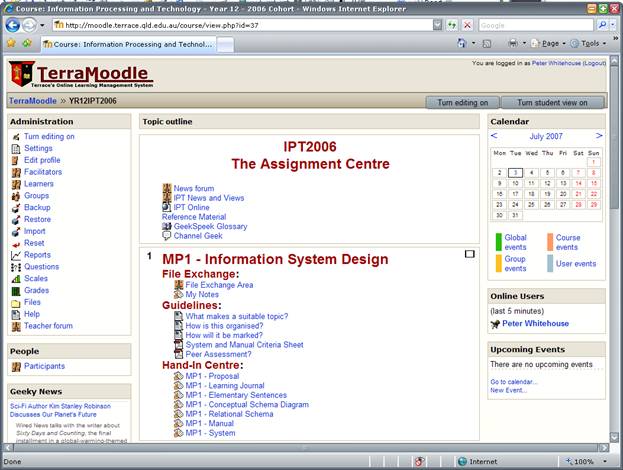
Within the Moodle, teachers have a large selection of RESOURCE and ACTIVITY builders that allow you to define the scope and sequence of a task. In the above screen shot you can see a "Guidelines" section that contains much of the vertical scaffolding for the task – Meta documents as RESOURCES, providing overall details.
The "Hand-In Centre" provides the interactive ACTIVITIES that contain file uploaders for each section presented in a vertical sequence. Within each uploader, horizontal scaffolding provides details on how to successfully complete the stage.
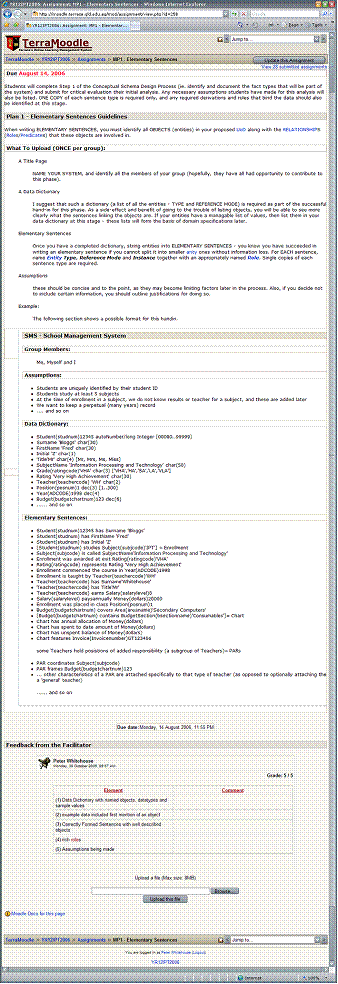 |
Rather than leave it to chance, I specify what would constitute an acceptable hand in, and provide an example of the style that the document should take. I take the time to enumerate the things I am looking for in this, a "completion" phase, and provide "nominal" marks for each of the key elements. The beauty of such a scheme is that students get immediate and useful feedback on the deficiencies of their hand in and rectify it immediately – this is particularly important in an assignment that is sequential – i.e. the next stage is dependent on the previous stage being completed successfully. The other benefits of the approach are that you take a huge task – in this case the development of a database system from scratch – and dissect it into smaller, more manageable chunks. Chunking is an important structural aid for students who struggle to understand things, and invaluable in keeping students organized. I am _not_ suggesting this is the only approach, but my preferred approach. I like these sorts of tools because I can leave helpful and persistent comments amongst their handed in work and that makes final grading that much less painful as I have been actively part of the development process. Students appreciate the extra care and attention to detail and have often remarked that they have felt supported but not constrained by this approach. |
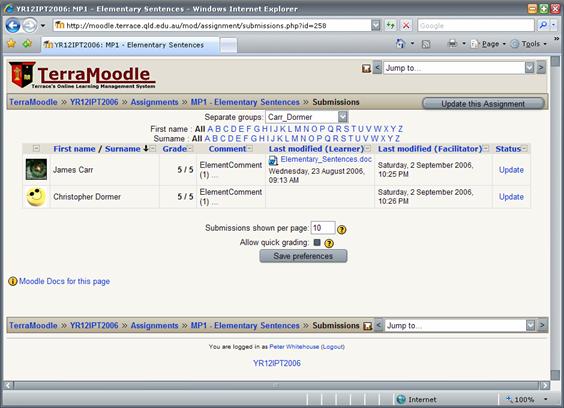
As the owner of the course, I get to manage student and group sections, and by "updating" I get to see the actual hand in, mark and make comments on it.
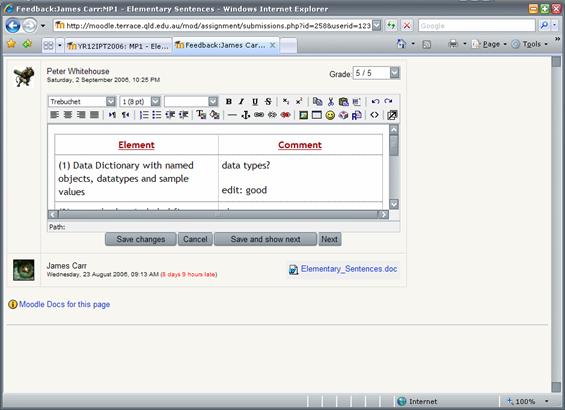
Those comments are immediately available back to the student.
Version control and document management can be achieved many ways, I like a solution that works the way students are used to – many routinely use forums and other online tools and the file exchange area is a forum that they control:
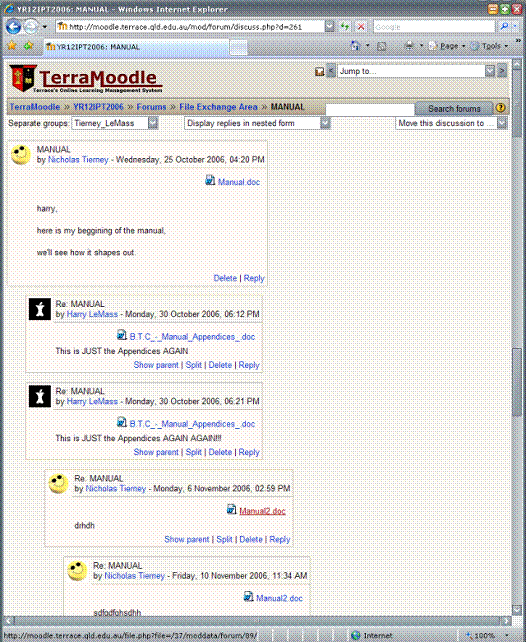
As a teacher, I value being able to see a document develop, and this provides vivid proof of authorship. The tool also allows me to contribute to the thread, suggesting refinements along the way.
In a Moodle, the course itself provides the vertical scaffolding, each element of the course (activities and resources) flesh out the scaffolding vertically. Far from " dumbing down" the task, this approach enriches and supports student learning and that, dear reader is what it should all be about.
Finding ways of getting kids to engage in learning is what any effective teacher strives to do. Evaluating the effectiveness of the chosen learning activities and bringing to a conscious level the decisions and procedures that enable that is what a professional teacher does.
Moodle, like MOO has many user management features that, as a teacher, I like – the ability to display user login and activity patterns, a rich collection of tools to set my learning experiences in and the engaging nature of the environment are all good reasons to adopt a technology. Breaking the barriers that are the four walls of the classroom, to facilitate learning outside of class time is also a compelling reason to consider such tools.
In this paper I have tried to look practically at the assignment setting process. As a panel chair I despaired at the mediocre assessment being used in certain schools and the lukewarm to disengaged responses elicited from students to those items, without surprise really. I have seen the power of a really good item, how it inspires the student to go beyond their understanding and those sorts of moments, sadly rare in a teacher's life, are what contribute to make the profession so satisfying.
I am not trying to set myself up here as an oracle of all that is good and correct in assessment. I am learning, and still making mistakes. My students still ask me questions that indicate that I have the design of the item wrong, and my district panel still suggests modifications to the ways I do things and that is fantastic. I love to learn about new ways to do things and would encourage you [presumably as you are interested enough to read this stuff to the end] to continually explore ways of connecting with your students in real and empowering ways.
If you have a question, please send me an email. I cannot guarantee an expert answer, but at least you will get what I reckon. Email: wonko@wonko.info
This document is available in a complete form in PDF format [820kb]
Join an active online teaching community and share your opinions/concerns ...
Mail me with your ideas/feedback - I'll post it for others to see if you like.